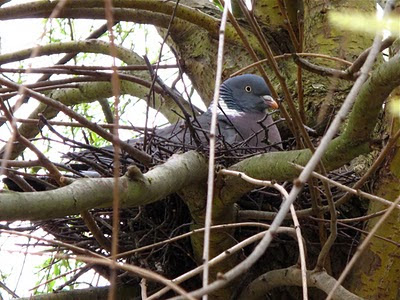A predated nest of long-tailed tit on the 25th of April this year, the intact nest is a ball with the outside made of a delicately shell of pieces of lichen attached with spider webs, the inside is a down and feather filling. It can take the pair up to three weeks to put together.
In contrast, if a brood is lost late in the season, individuals may turn to help other nest owners raise their brood, bringing food for their offspring, and actually increasing the fledging rate. Who do long-tailed tits help? The theory of kin-selection predicts that individuals should help their relatives for cooperative breeding to persist. Do long-tailed tits do this? How good are they discriminating their kin? Is the amount of help correlated with the degree of kinship? Prof. Ben Hatchwell, from the University of Sheffield, has been studying a population of long-tailed tits for over 14 years, and his research has provided wonderfully detailed insights on the reproductive behaviour of the long-tailed tit. Apparently long-tailed tits are able to recognize their kin through their contact calls. In a new study by Prof. Hatchwell's group, kin relationships between most individuals in a valley near Sheffield (U.K.) were assessed using pedigrees and genetic markers. Then they followed the nesting attempts - on real, amazingly cryptic nests, not in nest boxes! - and estimated provisioning rates by the different carers. This way they were able to document the relationships between helpers and the individuals they helped.
The first interesting result, is that social ties are very good predictors of paternity in this species, there were no instances of cukoldry. Pairs were monogamous for each breeding season. This meant that pedrigree data was a very good predictor of genetic relationships.
In many other cooperative breeders helpers often provision their siblings - that is, they are previous years offspring that delay they reproduction to help their parents raise another brood. In the case of the long-tailed tit, helping another nest is dependent on an own nesting failure, and there is a lot of diversity. Individuals can help their offspring, one or both parents, aunts and even a case of an individual helping a grandparent!. Most of the cases, however, involved individuals helping their siblings rear their nieces and nephews. This is possibly related to the high 'divorce' rates in long-tailed tits. Pairs are monogamous during a particular breeding season, but mortality is high (50% from one season to the next) and individuals often switch partners, therefore, the chances of a individual helping their parents is reduced. Also, siblings often disperse together to new territories so there is more opportunities to help a sibling than any other relative. In conclusion, most cases of help were to relatives, supporting kin-selection theory. However, things are often more complex than that: 23% of the helpers actually helped unrelated individuals. When the researchers looked at this in detail they saw that they were unrelated, but not unknown. Individuals helped other individuals with which they had social ties: previous year's partners - no hard feelings! or they helped in nests where another 'ex' was also helping. Maybe there is an element of reciprocity there. These results could make you think that long-tailed tits help guys they know, and the fact that they often help kin is just but the consequence that they tend to know their siblings socially, but it is more interesting than that.
Another, key prediction of kin selection theory: helpers should invest more the more related they are to the individuals they help (that is, helping is a cost and they should adjust the costs to the benefits). With their data of provisioning rates, they could indeed confirm that this is true: helpers provisioning rates increased with the relationship to the nestlings they fed.
Therefore long-tailed tits do recognise kin and preferentially assist them, providing support for the role of kin selection in the evolution of their breeding behaviour.
At the end of the breeding season, family groups come together in flocks, that will joining other tits and small birds and wander around the canopies throughout the winter.
More information
Nam, K., Simeoni, M., Sharp, S., & Hatchwell, B. (2010). Kinship affects investment by helpers in a cooperatively breeding bird Proceedings of the Royal Society B: Biological Sciences, 277 (1698), 3299-3306 DOI: 10.1098/rspb.2010.0737

















































